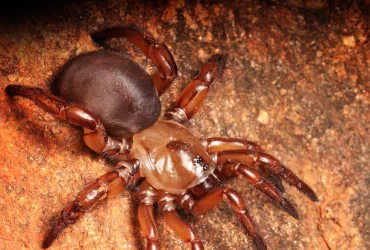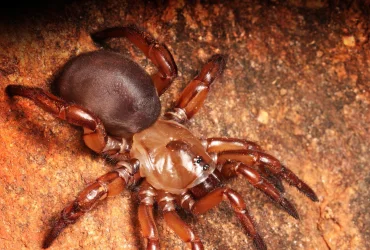Volume 9-14 (2020-26)
 v14i2.363
v14i2.363eISSN: 1800-427X (online)
DOI:10.47605/tapro.v14i2.363
Submitted date: 10 February 2025
Accepted date: 9 June 2025
Published date: 14 July 2025
Pp. 107–120.
A NEW DAY GECKO OF THE Cnemaspis podihuna (REPTILIA: GEKKONIDAE) CLADE FROM NORTHEAST INDIA
Amit Sayyed*, Madhurima Das, A.A. Thasun Amarasinghe, Rupankar Bhattacharjee & Jayaditya Purkayastha
*Corresponding author. E-mail: amitsayyedsatara@gmail.com
Abstract
We describe a new species of Cnemaspis from Assam, a valley of an antecedent river, the Brahmaputra, in northeastern India that belongs to the C. podihuna species group. The new species is the second Cnemaspis reported from the mainland Indian subcontinent, representing the entire podihuna clade. It is small (SVL 30.8–35.7 mm) and diurnal. The new species is genetically and morphologically allied to C. assamensis in northeast India, and also morphologically allied to the members of the C. podihuna group in Sri Lanka, especially to C. molligodai and C. manoae, but is distinguished by its larger body size but with lower number of midbody scale rows, higher number of miventrals and ventral scale rows across the belly, no tubercles on lower flanks, three enlarged rows of thigh scales parallel to the enlarged femoral scale row, and fewer poreless scales separating precloacal and femoral pore scales in males. The new species is also genetically divergent from C. assamensis by p-distances of 6.0–7.2% and from Sri Lankan congeners by 21.2–24.8% in the mitochondrial ND2 gene. With this new species, only two species of Cnemaspis are now known from the podihuna clade in India, but additional species likely remain unrecognized.
Section Editor: Suranjan Karunarathna
LSID:urn:lsid:zoobank.org
DOI:10.47605/tapro.v14i2.363
Submitted date: 10 February 2025
Accepted date: 9 June 2025
Published date: 14 July 2025
Pp. 107–120.
A NEW DAY GECKO OF THE Cnemaspis podihuna (REPTILIA: GEKKONIDAE) CLADE FROM NORTHEAST INDIA
Amit Sayyed*, Madhurima Das, A.A. Thasun Amarasinghe, Rupankar Bhattacharjee & Jayaditya Purkayastha
*Corresponding author. E-mail: amitsayyedsatara@gmail.com
Abstract
We describe a new species of Cnemaspis from Assam, a valley of an antecedent river, the Brahmaputra, in northeastern India that belongs to the C. podihuna species group. The new species is the second Cnemaspis reported from the mainland Indian subcontinent, representing the entire podihuna clade. It is small (SVL 30.8–35.7 mm) and diurnal. The new species is genetically and morphologically allied to C. assamensis in northeast India, and also morphologically allied to the members of the C. podihuna group in Sri Lanka, especially to C. molligodai and C. manoae, but is distinguished by its larger body size but with lower number of midbody scale rows, higher number of miventrals and ventral scale rows across the belly, no tubercles on lower flanks, three enlarged rows of thigh scales parallel to the enlarged femoral scale row, and fewer poreless scales separating precloacal and femoral pore scales in males. The new species is also genetically divergent from C. assamensis by p-distances of 6.0–7.2% and from Sri Lankan congeners by 21.2–24.8% in the mitochondrial ND2 gene. With this new species, only two species of Cnemaspis are now known from the podihuna clade in India, but additional species likely remain unrecognized.
Section Editor: Suranjan Karunarathna
LSID:urn:lsid:zoobank.org
 v14i2.362
v14i2.362eISSN: 1800-427X (online)
DOI:10.47605/tapro.v14i2.362
Submitted date: 23 February 2025
Accepted date: 30 April 2025
Published date: 17 June 2025
Pp. 99–106.
A NEW SPECIES OF AMPHIDROMOUS GOBY (TELEOSTEI: OXUDERCIDAE: Stiphodon) FROM ENGGANO ISLAND, INDONESIA
N. Nurjirana*, Rudhy Gustiano, H. Haryono & Kunto Wibowo
*Corresponding author. E-mail: nurjirana@brin.go.id
Abstract
A new amphidromous goby species of the genus Stiphodon Weber, 1895, is described based on eight specimens collected from Enggano Island, Indonesia. A combination of the following characteristics distinguishes the new species from all other congeners: form of the fourth dorsal spine of the first dorsal fin group elongated, filamentous and without membrane, spotting on head and fin, preanal length 49–55% of standard length (SL), second dorsal length 38−45% of SL, anal fin length 42−47% of SL, caudal fin length 30−34% of SL, number of premaxilary teeth ranging from 25−33, canine-like teeth 2−5, number of scales in transverse forward series 5−9, number of scales in zig-zag series 5−8.
Section Editor: Veryl Hasan
LSID:urn:lsid:zoobank.org
DOI:10.47605/tapro.v14i2.362
Submitted date: 23 February 2025
Accepted date: 30 April 2025
Published date: 17 June 2025
Pp. 99–106.
A NEW SPECIES OF AMPHIDROMOUS GOBY (TELEOSTEI: OXUDERCIDAE: Stiphodon) FROM ENGGANO ISLAND, INDONESIA
N. Nurjirana*, Rudhy Gustiano, H. Haryono & Kunto Wibowo
*Corresponding author. E-mail: nurjirana@brin.go.id
Abstract
A new amphidromous goby species of the genus Stiphodon Weber, 1895, is described based on eight specimens collected from Enggano Island, Indonesia. A combination of the following characteristics distinguishes the new species from all other congeners: form of the fourth dorsal spine of the first dorsal fin group elongated, filamentous and without membrane, spotting on head and fin, preanal length 49–55% of standard length (SL), second dorsal length 38−45% of SL, anal fin length 42−47% of SL, caudal fin length 30−34% of SL, number of premaxilary teeth ranging from 25−33, canine-like teeth 2−5, number of scales in transverse forward series 5−9, number of scales in zig-zag series 5−8.
Section Editor: Veryl Hasan
LSID:urn:lsid:zoobank.org
 v14i2.361
v14i2.361eISSN: 1800-427X (online)
DOI:10.47605/tapro.v14i2.361
Submitted date: 29 September 2024
Accepted date: 5 May 2025
Published date: 15 June 2025
Pp. 88–98.
AN OVERVIEW OF HUMAN-SNAKE CONFLICT FROM 2015 TO 2023 IN INDONESIA
Quraisy Zakky, Arief P. Handoyo, Tun Susdiyanti, Maula H. Dafa & Amir Hamidy*
*Corresponding author. E-mail: hamidyamir@gmail.com
Abstract
Human-snake interactions are one of the most common forms of human-wildlife conflict since many snakes are known to be adapted to anthropogenic environments. We gathered evidence from social media and online newsletters on conflicts among 109 species, 56 genera, and 12 families throughout 38 provinces in Indonesia between 2015 and 2023. West Java emerged as a hotspot for human-snake conflicts, followed by other regions on the island of Java. Malayopython reticulatus had the highest conflict rates in Indonesia (n=165, 8.81%) and had the highest tendency to enter human settlements (n=138, 10.92%). Naja sputatrix is reported to have the highest rates of being killed (n=44, 11.76%), while Calloselasma rhodostoma[/]i and [i]Trimeresurus insularis are reported to show the highest incidence of bites (both n=37, 16.30%). Our data provides fundamental information for the Indonesian government to inform human-snake conflict mitigation programs.
Section Editor: Scott Eipper
DOI:10.47605/tapro.v14i2.361
Submitted date: 29 September 2024
Accepted date: 5 May 2025
Published date: 15 June 2025
Pp. 88–98.
AN OVERVIEW OF HUMAN-SNAKE CONFLICT FROM 2015 TO 2023 IN INDONESIA
Quraisy Zakky, Arief P. Handoyo, Tun Susdiyanti, Maula H. Dafa & Amir Hamidy*
*Corresponding author. E-mail: hamidyamir@gmail.com
Abstract
Human-snake interactions are one of the most common forms of human-wildlife conflict since many snakes are known to be adapted to anthropogenic environments. We gathered evidence from social media and online newsletters on conflicts among 109 species, 56 genera, and 12 families throughout 38 provinces in Indonesia between 2015 and 2023. West Java emerged as a hotspot for human-snake conflicts, followed by other regions on the island of Java. Malayopython reticulatus had the highest conflict rates in Indonesia (n=165, 8.81%) and had the highest tendency to enter human settlements (n=138, 10.92%). Naja sputatrix is reported to have the highest rates of being killed (n=44, 11.76%), while Calloselasma rhodostoma[/]i and [i]Trimeresurus insularis are reported to show the highest incidence of bites (both n=37, 16.30%). Our data provides fundamental information for the Indonesian government to inform human-snake conflict mitigation programs.
Section Editor: Scott Eipper
 v14i1.360
v14i1.360eISSN: 1800-427X (online)
DOI:10.47605/tapro.v14i1.360
Submitted date: 15 February 2025
Accepted date: 21 April 2025
Published date: 31 May 2025
Pp. 85–87.
Escaping the cage: Range expansion of the grosbeak starling in Borneo
Mukhlisi, D.A. Putra, T. Atmoko, R. Garsetiasih & S. Hadi
*Corresponding author. E-mail: mukhlisi.arkan@gmail.com
The grosbeak starling (Scissirostrum dubium), also known as the finch-billed Myna, is an endemic bird species of Sulawesi and several surrounding satellite islands. It is distinctive among starlings in having a thick yellow bill and stiff, waxy red feathers on the rump. According to the IUCN Red List, this species is currently classified as Least Concern (LC), but its global population is declining due to habitat destruction, fragmentation, and illegal hunting. One of the major threats is the loss of suitable nesting sites, as trees are essential for providing shelter and breeding grounds. A study conducted in Central Sulawesi even found a population collapse, with 92% of nests disappearing due to the loss of remnant trees.
Section Editor: Richard A. Noske
DOI:10.47605/tapro.v14i1.360
Submitted date: 15 February 2025
Accepted date: 21 April 2025
Published date: 31 May 2025
Pp. 85–87.
Escaping the cage: Range expansion of the grosbeak starling in Borneo
Mukhlisi, D.A. Putra, T. Atmoko, R. Garsetiasih & S. Hadi
*Corresponding author. E-mail: mukhlisi.arkan@gmail.com
The grosbeak starling (Scissirostrum dubium), also known as the finch-billed Myna, is an endemic bird species of Sulawesi and several surrounding satellite islands. It is distinctive among starlings in having a thick yellow bill and stiff, waxy red feathers on the rump. According to the IUCN Red List, this species is currently classified as Least Concern (LC), but its global population is declining due to habitat destruction, fragmentation, and illegal hunting. One of the major threats is the loss of suitable nesting sites, as trees are essential for providing shelter and breeding grounds. A study conducted in Central Sulawesi even found a population collapse, with 92% of nests disappearing due to the loss of remnant trees.
Section Editor: Richard A. Noske
 v14i1.359
v14i1.359eISSN: 1800-427X (online)
DOI:10.47605/tapro.v14i1.359
Submitted date: 27 January 2025
Accepted date: 21 April 2025
Published date: 31 May 2025
Pp. 82–84.
The genus Typhonium Schott (Araceae) in Java, Indonesia
A.S.D. Irsyam, I.P.A. Husaini, Harto &
M.R. Hariri
*Corresponding author. E-mail: muhammad.rifqi.hariri@brin.go.id
The genus Typhonium Schott comprises more than 70 species with a vast geographic range, extending from Mongolia through tropical regions of Asia and reaching as far south as northern and eastern Australia.The genus consists of small, seasonal geophytic herbs with a (sub)globose tuber or short rhizome. Leaves vary in number and shape, ranging from simple to decompound with diverse leaflet forms. Inflorescences typically emerge after leaf development on a short or long peduncle. The spathe, ovate to lanceolate, is divided by a constriction below the staminate zone, with a limb often coloured pale to deep purple, rarely whitish or pinkish. The spadix includes a basal pistillate zone, a sterile zone with staminodes, a staminate zone, and a sterile appendix that varies in length, shape, and orientation, from erect to pendulous, narrowly conical to tail-like.
Section Editor: Russell L. Barrett
DOI:10.47605/tapro.v14i1.359
Submitted date: 27 January 2025
Accepted date: 21 April 2025
Published date: 31 May 2025
Pp. 82–84.
The genus Typhonium Schott (Araceae) in Java, Indonesia
A.S.D. Irsyam, I.P.A. Husaini, Harto &
M.R. Hariri
*Corresponding author. E-mail: muhammad.rifqi.hariri@brin.go.id
The genus Typhonium Schott comprises more than 70 species with a vast geographic range, extending from Mongolia through tropical regions of Asia and reaching as far south as northern and eastern Australia.The genus consists of small, seasonal geophytic herbs with a (sub)globose tuber or short rhizome. Leaves vary in number and shape, ranging from simple to decompound with diverse leaflet forms. Inflorescences typically emerge after leaf development on a short or long peduncle. The spathe, ovate to lanceolate, is divided by a constriction below the staminate zone, with a limb often coloured pale to deep purple, rarely whitish or pinkish. The spadix includes a basal pistillate zone, a sterile zone with staminodes, a staminate zone, and a sterile appendix that varies in length, shape, and orientation, from erect to pendulous, narrowly conical to tail-like.
Section Editor: Russell L. Barrett
Hubungi Kami
The ultimate aim of the journal is to provide an effective medium for communication of the latest and best scientific information.
Copyright © 2020 Taprobanica. All Rights Reserved
Jasa Pembuatan Website by IKT




